KNES 373 Quiz 2
5.0(1)
5.0(1)
Card Sorting
1/103
Earn XP
Description and Tags
Study Analytics
Name | Mastery | Learn | Test | Matching | Spaced |
|---|
No study sessions yet.
104 Terms
1
New cards
What is the biological function of our body? (2)
* Extracts potential energy from food & conserve it in ATP bonds
* Transfers the chemical energy of ATP to biological work
* Transfers the chemical energy of ATP to biological work
2
New cards
ATP will be used for:
Chemical work
Mechanical work
Transport work
Mechanical work
Transport work
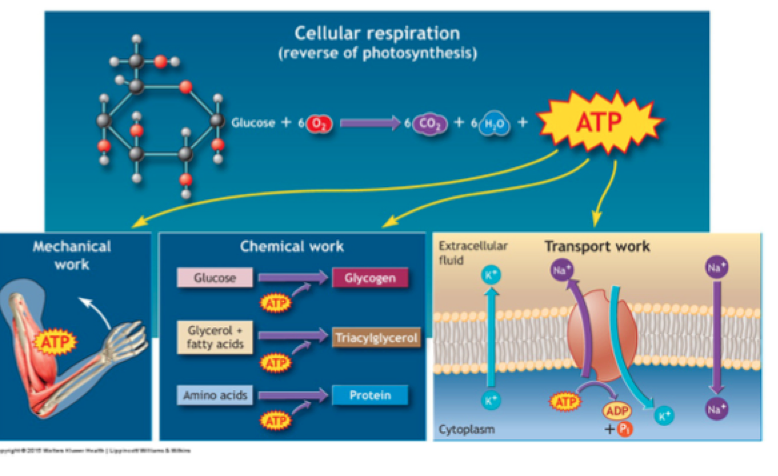
3
New cards
Describe the structure of ATP
Adenosine Triphosphate
* 3 phosphate groups
* 1 Adenosine
* 3 phosphate groups
* 1 Adenosine
4
New cards
Between which phosphate group does the bond break & how much energy is released?
* The bond breaks between phosphates 2 & 3
* 7.3 Kcal free energy is liberated (reduced) + Pi
\
* 7.3 Kcal free energy is liberated (reduced) + Pi
\
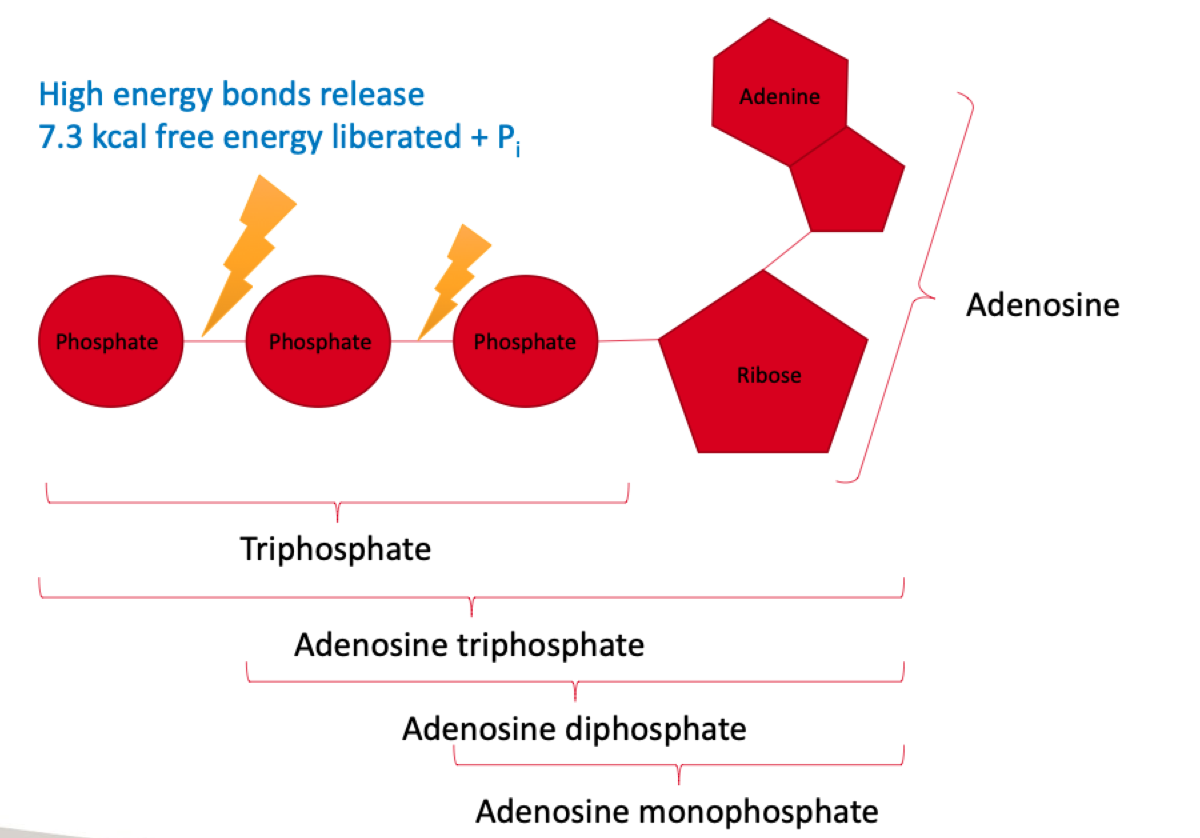
5
New cards
Through what process is ATP broken down?
Describe this process
What enzyme is used
Describe this process
What enzyme is used
ATP hydrolysis
* Decomposition reaction with water
* ATP + H2O → ADP + Pi + (-7.3 kcal)
* Enzyme: ATPase
* Decomposition reaction with water
* ATP + H2O → ADP + Pi + (-7.3 kcal)
* Enzyme: ATPase
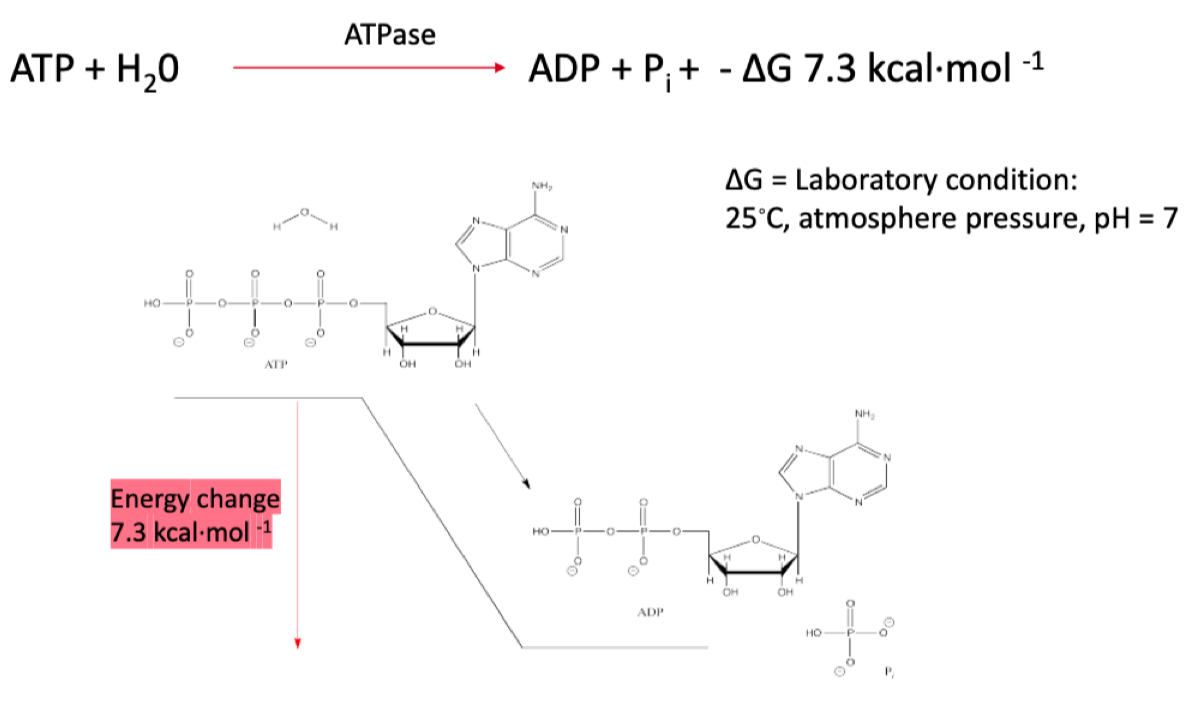
6
New cards
Describe the general process through which potential energy is transferred from food to ATP
* Energy is transferred using chemical compounds
\
* Food energy is released in small quantities through **stepwise metabolic reactions**
\
* Energy released by a reaction is transferred to chemical structures of another molecule (not in a form of heat)
\
* The food has a very high Ep, as it gets broken down ATP is produced & Ep decreases (think of burger)
\
* Food energy is released in small quantities through **stepwise metabolic reactions**
\
* Energy released by a reaction is transferred to chemical structures of another molecule (not in a form of heat)
\
* The food has a very high Ep, as it gets broken down ATP is produced & Ep decreases (think of burger)
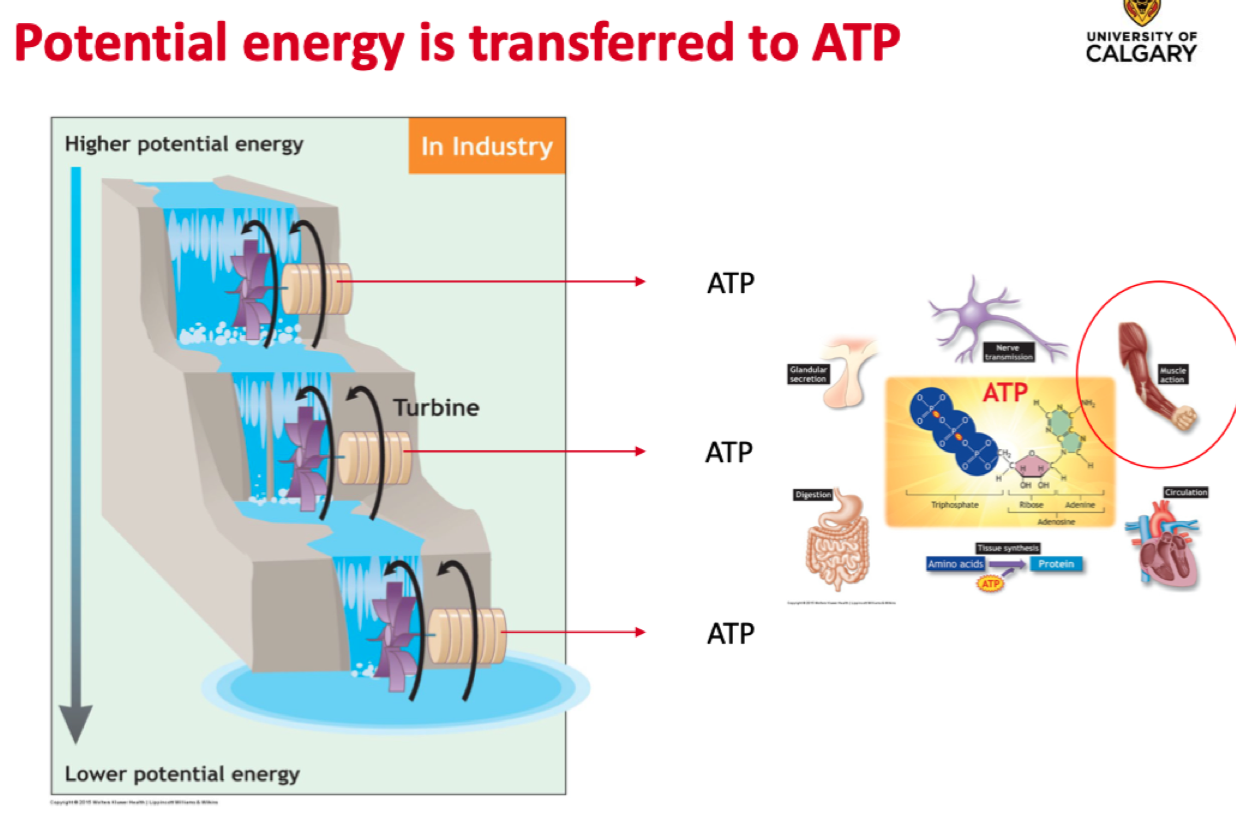
7
New cards
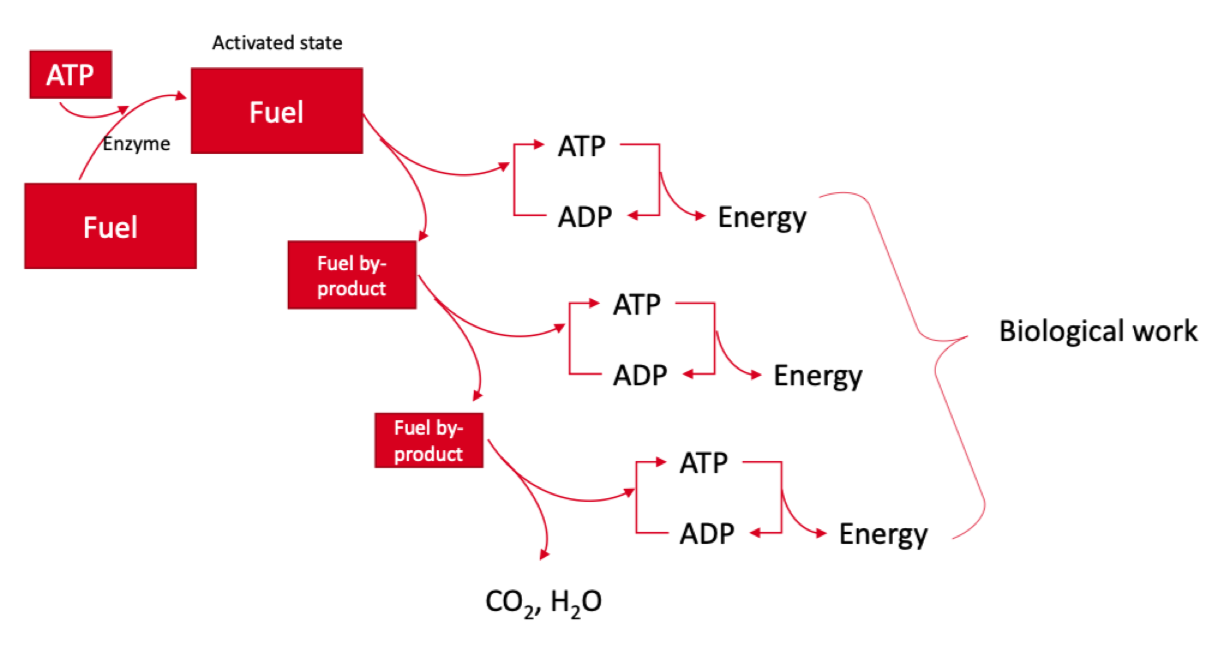
Describe this diagram:
* ATP is added to fuel due to the **thermic effect of feeding** (energy required to break down food)
\
* Each process requires energy & energy is lost to heat in all reactions
\
* Each rectangle decreases in size with each stage because potential energy gets weaker as the stages progress
\
* Each process requires energy & energy is lost to heat in all reactions
\
* Each rectangle decreases in size with each stage because potential energy gets weaker as the stages progress
8
New cards
How much ATP is stored in our body & why
80-100g of ATP mostly stored in muscle cells
Why?
* ATP is recycled (we resynthesize it)
* via anabolism & catabolism
* ATP is a very big molecule & having a lot is not very efficient
Why?
* ATP is recycled (we resynthesize it)
* via anabolism & catabolism
* ATP is a very big molecule & having a lot is not very efficient
9
New cards
Why do we have a limited amount of ATP
By having a small amount of ATP, any changes in its concentration will be quickly detected & the corresponding metabolic responses will be activated
10
New cards
What are enzymes
Related to the **rate** that cells transfer energy
\
Proteins that accelerate a chemical reaction by reducing its **activation energy**
* less energy needed to initiate reaction
\
Proteins that accelerate a chemical reaction by reducing its **activation energy**
* less energy needed to initiate reaction
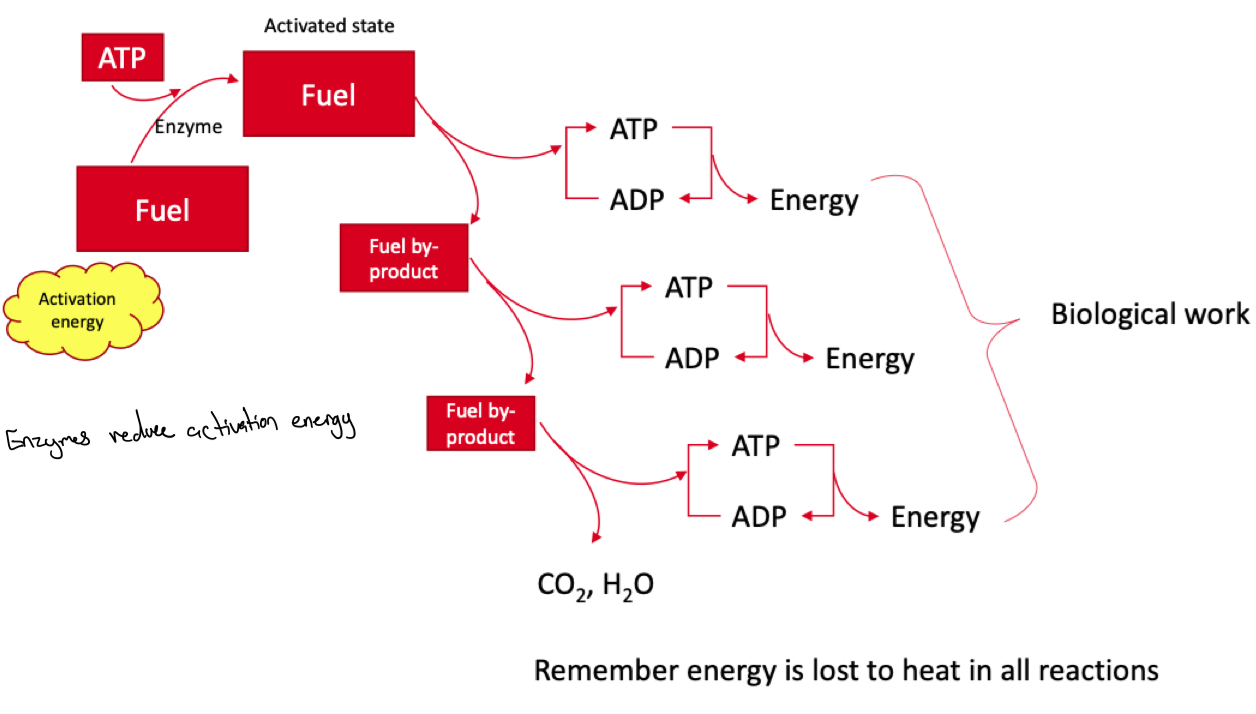
11
New cards
Describe the important properties of enzymes:
* Do not cause the reaction
* Do not change energy yield of reaction
* output stays the same
* Are not consumed or changed during reaction
* reusable
* Sensitive to changes in temperature & pH
* sometimes they react to changes in pH and/or temp
* Do not change energy yield of reaction
* output stays the same
* Are not consumed or changed during reaction
* reusable
* Sensitive to changes in temperature & pH
* sometimes they react to changes in pH and/or temp
12
New cards
Describe the Lock & Key Hypothesis
Substrate fits into the active site of the enzyme like a lock fitting a key (highly specific)
\
The enzyme itself doesn’t change at all but it facilitates the breakdown of a substrate
\
The enzyme itself doesn’t change at all but it facilitates the breakdown of a substrate
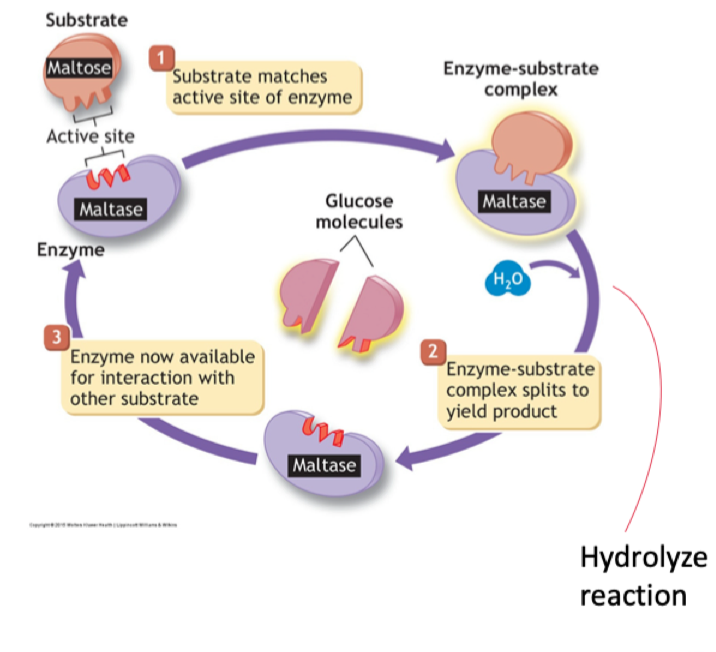
13
New cards
Name three types of enzymatic reactions
Hydrolysis reactions
\
Condensation reactions
\
Enzymatic (Oxidation & reduction) reactions
\
Condensation reactions
\
Enzymatic (Oxidation & reduction) reactions
14
New cards
Describe hydrolysis reactions
* Decomposition reaction with **water**
* catabolize/degrade complex molecules
* a molecule of water is added to a substance; thus, both substance & water molecule to split into 2 parts
\
1 big molecule breaks-down into 2 sub-molecules with water
* catabolize/degrade complex molecules
* a molecule of water is added to a substance; thus, both substance & water molecule to split into 2 parts
\
1 big molecule breaks-down into 2 sub-molecules with water

15
New cards
Describe condensation reactions
* Opposite of hydrolysis
* two molecules combine to build a single larger molecule with the loss of water
* water is produced from the reaction
\
* the process where water vapour in the air is changed into liquid water
* two molecules combine to build a single larger molecule with the loss of water
* water is produced from the reaction
\
* the process where water vapour in the air is changed into liquid water

16
New cards
Describe enzymatic reactions
* Oxidation - losing electrons
* Reduction - gaining electrons
\
* aka REDOX reactions
\
* Oxidation & reduction always happens together
\
* Often involve coenzymes
* Reduction - gaining electrons
\
* aka REDOX reactions
\
* Oxidation & reduction always happens together
\
* Often involve coenzymes
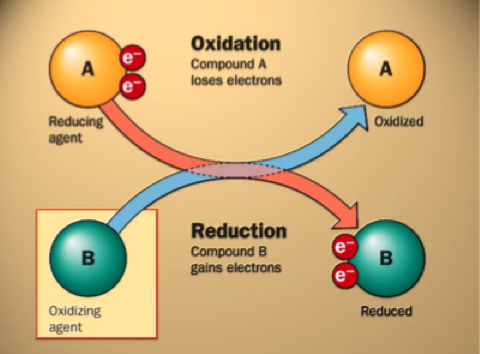
17
New cards
Where do muscle cells use ATP? (distribution)
**75% mechanical work**
* Myosin ATPase (breaking myosin-actin cross-bridges)
\
**20%** **SERCA**
* Sarco/endoplasmic reticulum ATPase
* calcium withdrawal/reuptake following contraction (taking Ca2+ from endoplasmic reticulum back to SR)
\
**5% Ionic Transfer**
* Na+/K+ ATPase
* moving sodium & potassium in & out of the cell
* Myosin ATPase (breaking myosin-actin cross-bridges)
\
**20%** **SERCA**
* Sarco/endoplasmic reticulum ATPase
* calcium withdrawal/reuptake following contraction (taking Ca2+ from endoplasmic reticulum back to SR)
\
**5% Ionic Transfer**
* Na+/K+ ATPase
* moving sodium & potassium in & out of the cell
18
New cards
What signals are used to match ATP demand with ATP synthesis?
**Ca2+**
* ↑ in Ca2+ means we need to resynthesize ATP via troponin/tropomyosin
\
**Metabolites**
* ADP, AMP, Pi, H+
\
**Mitochondrial reduction/oxidation state**
* NAD+/NADH
* ↑ in Ca2+ means we need to resynthesize ATP via troponin/tropomyosin
\
**Metabolites**
* ADP, AMP, Pi, H+
\
**Mitochondrial reduction/oxidation state**
* NAD+/NADH
19
New cards
What are the 3 metabolic pathways to resynthesize ATP
**Immediate / phosphagen / alactic system (ATP-PCr system)**
* Adenosine triphosphate & phosphocreatine
\
**Glycolytic / lactic / anaerobic system**
* glycogenolysis & glycolysis
* lactate production
* fastest pathway
\
**Oxidative / aerobic system**
* different sources (carbs, lipids, protein, lactate)
* oxidative phosphorylation
* Adenosine triphosphate & phosphocreatine
\
**Glycolytic / lactic / anaerobic system**
* glycogenolysis & glycolysis
* lactate production
* fastest pathway
\
**Oxidative / aerobic system**
* different sources (carbs, lipids, protein, lactate)
* oxidative phosphorylation
20
New cards
How does the immediate system resynthesize ATP?
\
What are the two reactions of the immediate system?
\
What are the two reactions of the immediate system?
Resynthesizes it via **stored ATP**
\
* Phosphocreatine (PCr)
* PCr + ADP + H+ → ATP + Cr
* used to resynthesize ATP
\
* Adenylate Kinase
* ADP + ADP → ATP + AMP
\
ATP → ADP + Pi + H+
* enzyme: ATPase
\
\
* Phosphocreatine (PCr)
* PCr + ADP + H+ → ATP + Cr
* used to resynthesize ATP
\
* Adenylate Kinase
* ADP + ADP → ATP + AMP
\
ATP → ADP + Pi + H+
* enzyme: ATPase
\
21
New cards
Describe Creatine Kinase
\
Activated by:
\
Activated by:
PCr + ADP + H+ → ATP + Cr
* Occurring all the time
\
First line of defense - ATP buffer
* b/c we have way more PCr than ATP
\
Activated by:
* ↑ ADP
* ↓ ATP
* Occurring all the time
\
First line of defense - ATP buffer
* b/c we have way more PCr than ATP
\
Activated by:
* ↑ ADP
* ↓ ATP
22
New cards
Describe Adenylate Kinase
Myokinase (ADK) / Adenylate Kinase (ADK)
\
Quantitatively insignificant source of ATP during exercise
* occurs during high-intensity exercise
* removes adenine nucleotides from pool (increases recovery time)
\
ADP + ADP → ATP + AMP
* AMP + H+ → IMP + NH4+
\
Quantitatively insignificant source of ATP during exercise
* occurs during high-intensity exercise
* removes adenine nucleotides from pool (increases recovery time)
\
ADP + ADP → ATP + AMP
* AMP + H+ → IMP + NH4+
23
New cards
Describe the immediate / ATP-PCr system
\
When does it occur?
\
What happens as soon as muscle contraction starts?
\
What happens at exhaustion?
\
When does it occur?
\
What happens as soon as muscle contraction starts?
\
What happens at exhaustion?
Can act in the presence of oxygen but doesn’t need it
\
Occurs during the **first few seconds of exercise (3-15s)**
* ATP is maintained but PCr decreases
\
As soon as muscle contraction starts:
* ATP is hydrolized to ADP + Pi + H+
* ↑ Ca2+ and by-products (ADP, Pi, H+)
* Ca2+ & by-products activate CK enzyme
* CK accelerates breakdown of PCr
* PCr gives one Pi to ADP to resynthesize AT
* PCr + ADP + H+ → ATP + Cr
\
The ATP that’s generated frmo the oxidative metabolism will be used to synthesize PCr
\
At exhaustion:
* Both ATP & PCr decreases which prevents further muscle contractions
\
Occurs during the **first few seconds of exercise (3-15s)**
* ATP is maintained but PCr decreases
\
As soon as muscle contraction starts:
* ATP is hydrolized to ADP + Pi + H+
* ↑ Ca2+ and by-products (ADP, Pi, H+)
* Ca2+ & by-products activate CK enzyme
* CK accelerates breakdown of PCr
* PCr gives one Pi to ADP to resynthesize AT
* PCr + ADP + H+ → ATP + Cr
\
The ATP that’s generated frmo the oxidative metabolism will be used to synthesize PCr
\
At exhaustion:
* Both ATP & PCr decreases which prevents further muscle contractions
24
New cards
What is **Rate Limiting Enzyme (RLE)**
Enzymes contributing to the control of the rate of a reaction
\
* The activity of RLE depends on accumulation of substrate further down the pathway
\
* The activity of RLE depends on accumulation of substrate further down the pathway
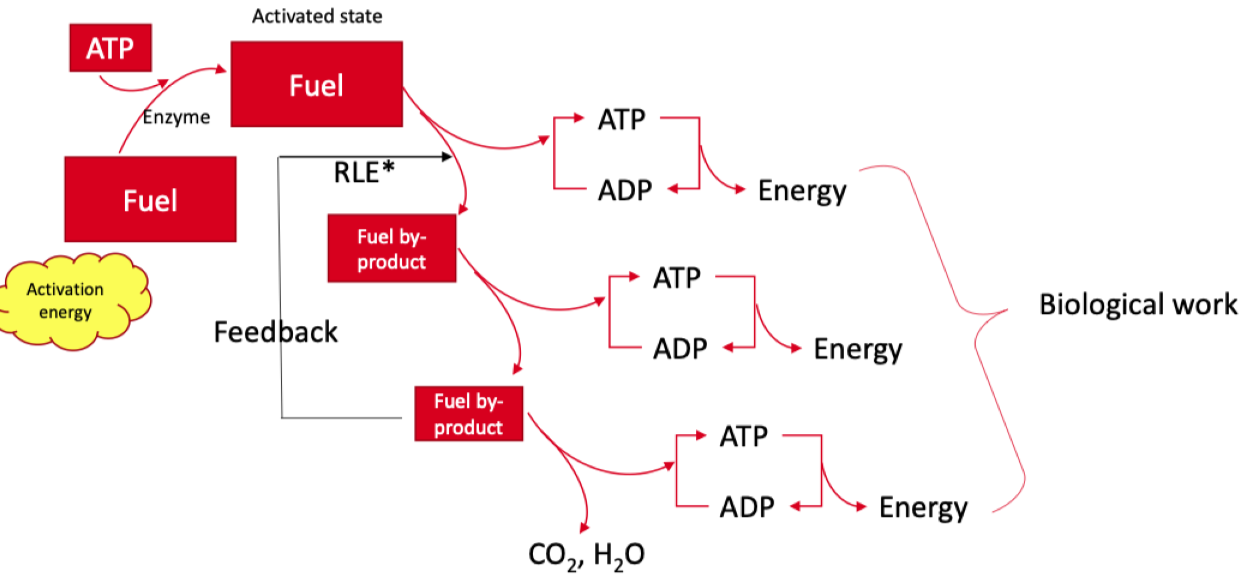
25
New cards
T/F: The reduction of ATP itself is a signal for ATP resynthesis
**FALSE**
\
Signals related to muscle contraction “turn on” pathways to generate ATP (e.g. Creatine kinase reaction)
\
Signals related to muscle contraction “turn on” pathways to generate ATP (e.g. Creatine kinase reaction)
26
New cards
ATP demand during exercise ↑ up to _______?
\
Minimal changes to _____ during exercise
\
Minimal changes to _____ during exercise
ATP demand during exercise ↑ up to 100-fold?
\
Minimal changes to ATP during exercise
\
Minimal changes to ATP during exercise
27
New cards
What 3 processes occur in the glycolytic system?
\
Where does glycolytic system take place
\
Where does glycolytic system take place
aka Anaerobic metabolism
* doesn’t need oxygen (happens in the presence of O2 but doesn’t need it)
\
Occurs outside mitochondria
\
1. Glycogenolysis
2. Glycolysis
3. Lactate Production
* doesn’t need oxygen (happens in the presence of O2 but doesn’t need it)
\
Occurs outside mitochondria
\
1. Glycogenolysis
2. Glycolysis
3. Lactate Production
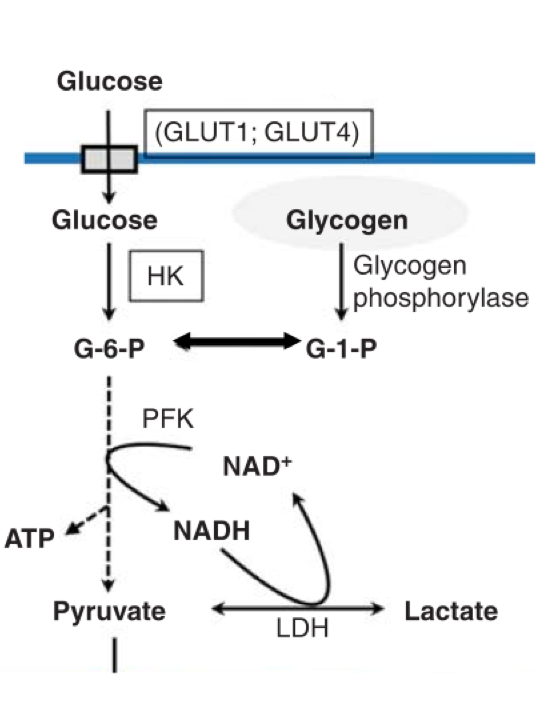
28
New cards
What is the fuel that can produce energy aerobically & anaerobically?
Carbohydrates
29
New cards
What is a Carbohydrate?
\
Where is it available during exercise?
\
Where is it available during exercise?
Only macronutrient that can generate ATP both anaerobically & aerobically
\
Available:
* blood
* muscle
* liver (to muscle via blood)
* ingested (from digestion to muscle via blood)
\
Available:
* blood
* muscle
* liver (to muscle via blood)
* ingested (from digestion to muscle via blood)
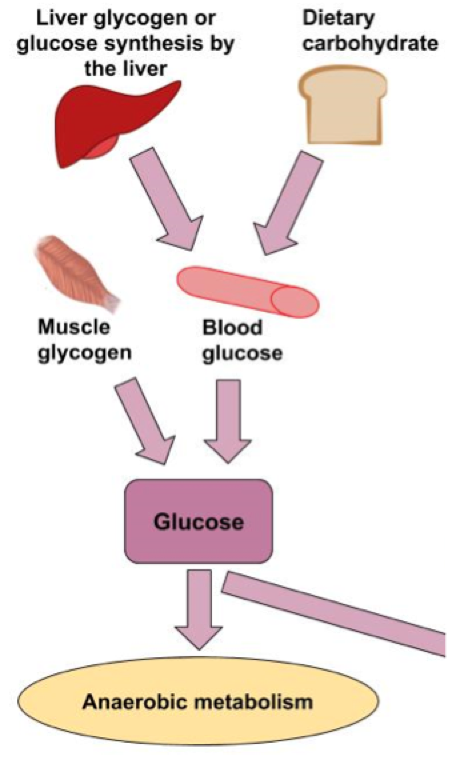
30
New cards
How does glucose enter a muscle cell?
\
______ sensitive
\
______ sensitive
Glucose transporter (GLUT4)
* transport protein (**not an enzyme**)
* specific to muscle cells
* facilitated diffusion
* follows concentration gradient
* insulin-sensitive
\
Indirect cascade that should occur
* transport protein (**not an enzyme**)
* specific to muscle cells
* facilitated diffusion
* follows concentration gradient
* insulin-sensitive
\
Indirect cascade that should occur
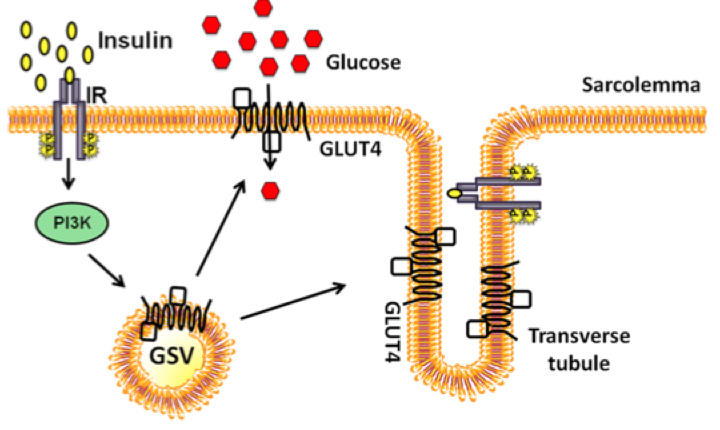
31
New cards
What happens to glucose when it enters a muscle cell?
Hexokinase (HK)
* Converts glucose to glucose-6-phosphate (G6P)
* ATP is hydrolized to ADP + Pi + H+
* Pi will be attached to glucose to produce G6P
* G6P **cannot** leave the cell (irreversible reaction)
\
* G6P has two fates:
* undergoes glycolysis
* stored as glycogen
* phosphoglucomutase converts G6P to G1P
* glycogen synthase converts G1P to glycogen
\
Phosphofructokinase (PFK)
* Rate-limiting enzyme
* activated by: ADP, AMP, Pi, G6G (subtrate)
* inhibited by: ATP, H+
\
Yields 2 ATP (Substrate level phosphorylation)
* Requires 2 ATP
* Produces 4 ATO
\
Yields 2 NADH + H+
* oxidized by laactate dehydrogenase
* Converts glucose to glucose-6-phosphate (G6P)
* ATP is hydrolized to ADP + Pi + H+
* Pi will be attached to glucose to produce G6P
* G6P **cannot** leave the cell (irreversible reaction)
\
* G6P has two fates:
* undergoes glycolysis
* stored as glycogen
* phosphoglucomutase converts G6P to G1P
* glycogen synthase converts G1P to glycogen
\
Phosphofructokinase (PFK)
* Rate-limiting enzyme
* activated by: ADP, AMP, Pi, G6G (subtrate)
* inhibited by: ATP, H+
\
Yields 2 ATP (Substrate level phosphorylation)
* Requires 2 ATP
* Produces 4 ATO
\
Yields 2 NADH + H+
* oxidized by laactate dehydrogenase
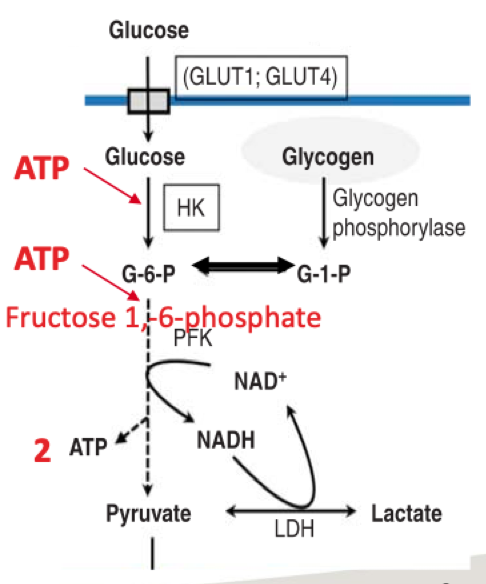
32
New cards
glucose → ? → ?
\
What type of reaction is this?
\
What type of reaction is this?
glucose → G6P → Pyruvate
\
What type of reaction is this?
REDOX reaction
\
What type of reaction is this?
REDOX reaction
33
New cards
What is the net ATP production from 1 glucose molecule?
2 Net ATP
34
New cards
Describe Glycogenolysis
\
Where does Glycogenolysis occur?
\
ATP produced?
\
Where does Glycogenolysis occur?
\
ATP produced?
* Occurs in sarcoplasm (outside mitochondria)
\
* Glycogen breaks down to Glucose-1-phosphate
\
* The reaction is catalyzed by glycogen phosphorylase (PHOS)
* Activated by PA
\
Yields **3** ATP
* Requires 1 ATP
* Produces 4 ATP
\
\
* Glycogen breaks down to Glucose-1-phosphate
\
* The reaction is catalyzed by glycogen phosphorylase (PHOS)
* Activated by PA
\
Yields **3** ATP
* Requires 1 ATP
* Produces 4 ATP
\
35
New cards
What is glycogen phosphorylase (PHOS)
\
What increases & decreases activity?
\
What increases & decreases activity?
* Rate-limiting enzyme
* Increased activity: Ca2+, AMP, Pi, epinephrine
* decreased activity: H+, ATP, G6P
\
* Increased activity: Ca2+, AMP, Pi, epinephrine
* decreased activity: H+, ATP, G6P
\
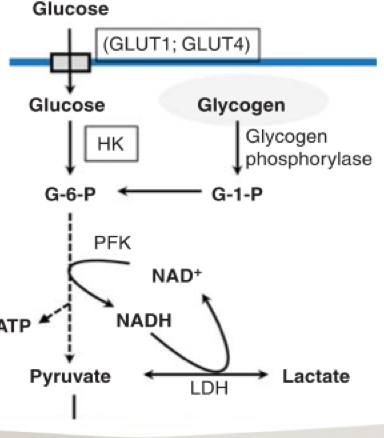
36
New cards

Fill out the table:

37
New cards
What is Lactate Dehydeogenase
Converts Pyruvate to lactate & lactate to pyruvate
\
When pyruvate & NADH + H+ accumulate, lactate is formed
* mismatch b/w glycolytic rate & capacity of mitochondria to accept pyruvate
\
When pyruvate & NADH + H+ accumulate, lactate is formed
* mismatch b/w glycolytic rate & capacity of mitochondria to accept pyruvate
38
New cards
Glucose gets converted to G6P w/ what enzyme?
\
G6P either gets converted to pyruvate or glycogen, what state do these occur & what enzymes facilitate them?
\
G6P either gets converted to pyruvate or glycogen, what state do these occur & what enzymes facilitate them?
Glucose → G6P (Hexokinase - HK)
\
G6P → Pyruvate (phosphofructokinase - PFK)
* When exercising
\
G6P → Glycogen (glycogen phosphorylase - PHOS)
* Not exercising
\
G6P → Pyruvate (phosphofructokinase - PFK)
* When exercising
\
G6P → Glycogen (glycogen phosphorylase - PHOS)
* Not exercising
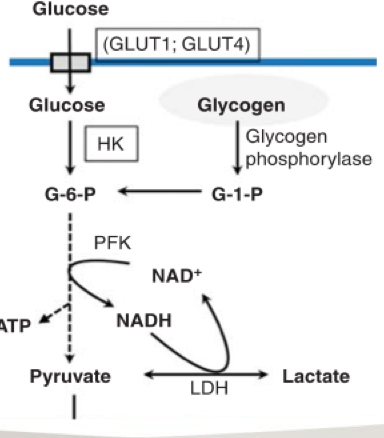
39
New cards
How does lactate get removed
Either goes out of the cell or gets converted back to pyruvate via LDH
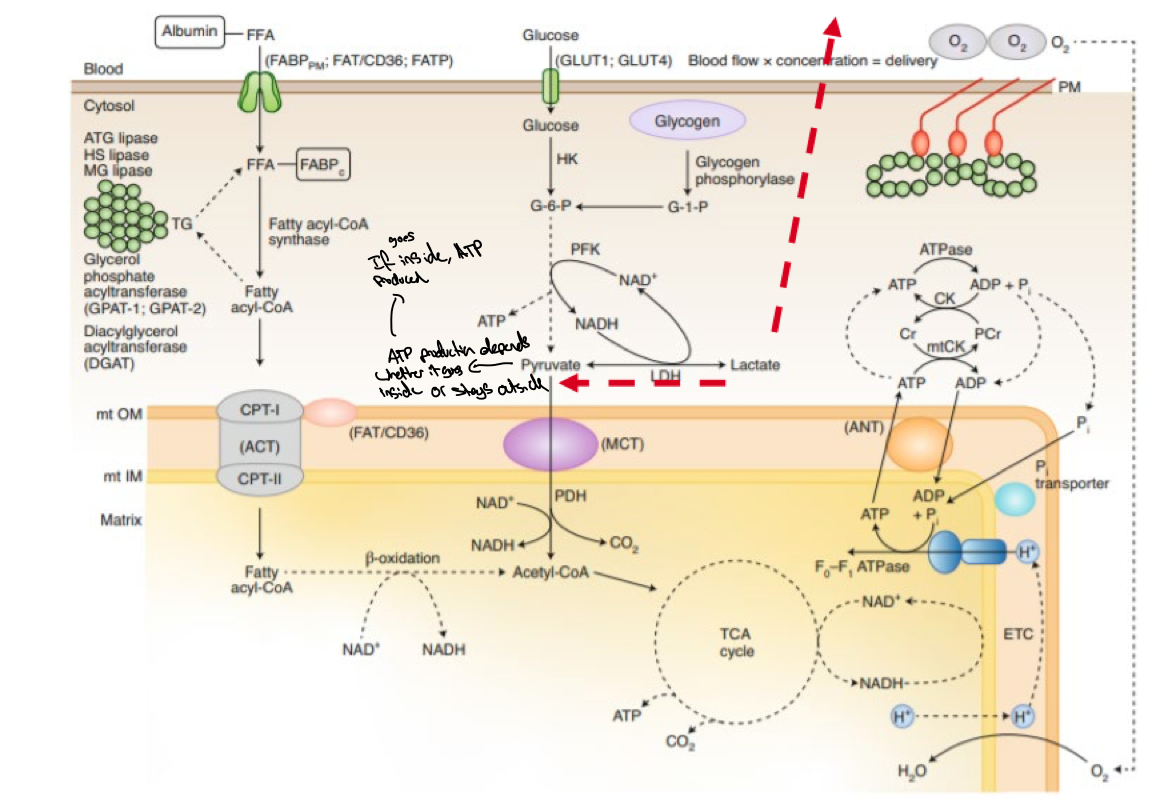
40
New cards
How does lactate production relate to exercise intensity?
Lactate cannot cause fatigue, H+ causes fatigue
\
Signal: ATP demand > aerobic metabolism ATP supply
\
Lactate increases to a certain point then remains constant because lactate starts to get converted to pyruvate
\
Signal: ATP demand > aerobic metabolism ATP supply
\
Lactate increases to a certain point then remains constant because lactate starts to get converted to pyruvate
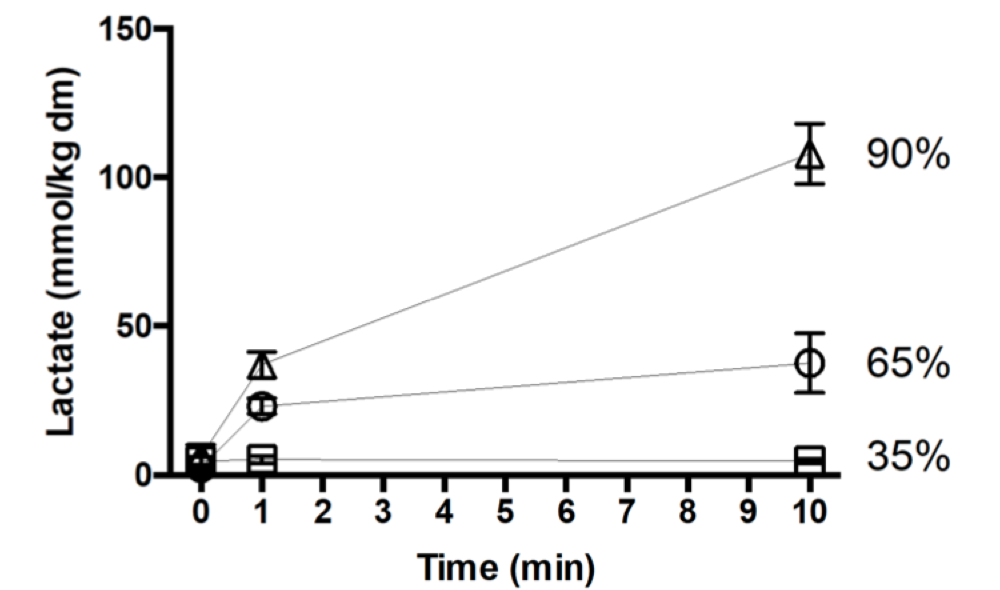
41
New cards
Describe energy metabolism during intense exercise (30s all-out cycling)
Throughout the 30s:
\
PCr contribution: ↓
\
Glycolysis Contribution: ↓
\
Oxidative phosphorylation contribution: ↑
\
PCr contribution: ↓
\
Glycolysis Contribution: ↓
\
Oxidative phosphorylation contribution: ↑
42
New cards
Anaerobic metabolism is critical for transitions to ? as well as ?
Anaerobic metabolism is critical for transitions to **higher workloads** as well as **maximal workloads**
43
New cards
Describe the enzymes of glygenolysis, glycolysis & lactate production
Glycogenolysis:
* glycogen phosphorylase (PHOS)
* phosphoglycomutase converts G1p to G6P
\
Glycolysis:
* Glucose transporter 4 (GLUT4)
* hexokinase (HK)
* phosphofructokinase (PFK)
\
Lactate production:
* lactate dehydrogenase (LDH)
* glycogen phosphorylase (PHOS)
* phosphoglycomutase converts G1p to G6P
\
Glycolysis:
* Glucose transporter 4 (GLUT4)
* hexokinase (HK)
* phosphofructokinase (PFK)
\
Lactate production:
* lactate dehydrogenase (LDH)
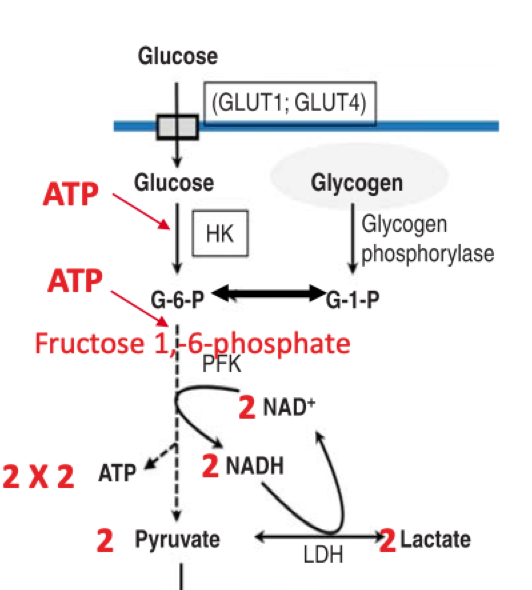
44
New cards
What is the end-product of glycolysis?
Depends on exercise intensity
\
Aerobic - pyruvate
anaerobic - lactate
\
Aerobic - pyruvate
anaerobic - lactate
45
New cards
What happens to pyruvate in the mitochondria?
* Goes to mitochondria matrix
\
* Pyruvate → Acetyl-CoA + CO2
* Facilitated by PDH
* NAD+ → NADH+H+
\
* In the conversion, each pyruvate molecule loses one carbon atom w/ the release of **carbon dioxide**
\
* during the breakdown of pyruvate, **electrons are transferred** to NAD+ to produce NADH, which will be used by the cell to produce ATP
\
* Pyruvate → Acetyl-CoA + CO2
* Facilitated by PDH
* NAD+ → NADH+H+
\
* In the conversion, each pyruvate molecule loses one carbon atom w/ the release of **carbon dioxide**
\
* during the breakdown of pyruvate, **electrons are transferred** to NAD+ to produce NADH, which will be used by the cell to produce ATP
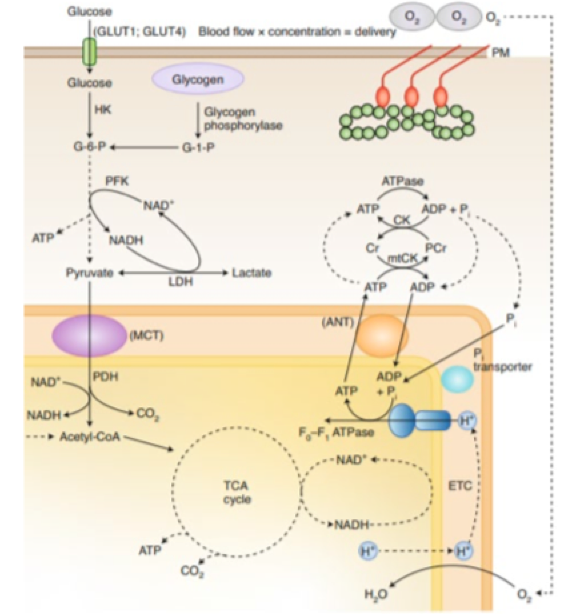
46
New cards
What is PDH
\
Purpose?
\
Activated/deactivated by
\
Purpose?
\
Activated/deactivated by
Pyruvate dehydrogenase
\
* Reduces the level of lactate
* controls rate of carbohydrate entry into mitochondria
* Activated by Ca2+
* deactivated by acetyl-CoA, ATP, NADH
\
Irrebersible: Traps acetyl-coA in mitochondria
\
* Reduces the level of lactate
* controls rate of carbohydrate entry into mitochondria
* Activated by Ca2+
* deactivated by acetyl-CoA, ATP, NADH
\
Irrebersible: Traps acetyl-coA in mitochondria
47
New cards
What is a Coenzyme?
\
Examples:
\
Examples:
A non-protein substance that is required for an enzyme to catalyze a reaction
* they cannot by themselves catalyze a reaction
\
Examples:
* NAD+ or NADH
* FAD or FADH2
\
NAD+ & FAD are electron transporters
* they cannot by themselves catalyze a reaction
\
Examples:
* NAD+ or NADH
* FAD or FADH2
\
NAD+ & FAD are electron transporters
48
New cards
What is the citric acid cycle?
\
Activated by?
\
What’s reformed each cycle?
\
Activated by?
\
What’s reformed each cycle?
Aka tricarboxylic acid (TCA) or Krebs cycle
\
Activated by: Ca2+, ADP, NAD+
\
Oxaloacetate is reformed each cycle
\
Activated by: Ca2+, ADP, NAD+
\
Oxaloacetate is reformed each cycle
49
New cards
What activates creatine kinase?
Changes in ATP (a decrease in ATP)
50
New cards
T/F Sensitivity of changes to ATP, ADP, etc change depending on the individual
TRUE
51
New cards
How does exercise intensity determine when pyruvate enters the cell?
Low intensity:
* Pyruvate can enter the cell (mitochondria)
\
High intensity:
* pyruvate begins to accumulate outside the cell & therefore gets converted to lactate
* Pyruvate can enter the cell (mitochondria)
\
High intensity:
* pyruvate begins to accumulate outside the cell & therefore gets converted to lactate
52
New cards
Why does lactate cause central fatigue?
It activates group III/IV afferents
53
New cards
What causes peripheral fatigue?
Pi & H+ ions
54
New cards
Draw the citric acid cycle
\
What is oxaloacetate?
\
What is oxaloacetate?
Oxaloacetate:
* Oil for the engine
* TCA cycle works w/ oxaloacetate (its always there)
\
Acetyl-Coa
* Raw material
\
ATP
* Currency of our muscles
\
NADH & FADH2
* Alternate forms of currency
* they go to bank (ETC) to get exchanged into dollars (usable currency)
* Oil for the engine
* TCA cycle works w/ oxaloacetate (its always there)
\
Acetyl-Coa
* Raw material
\
ATP
* Currency of our muscles
\
NADH & FADH2
* Alternate forms of currency
* they go to bank (ETC) to get exchanged into dollars (usable currency)
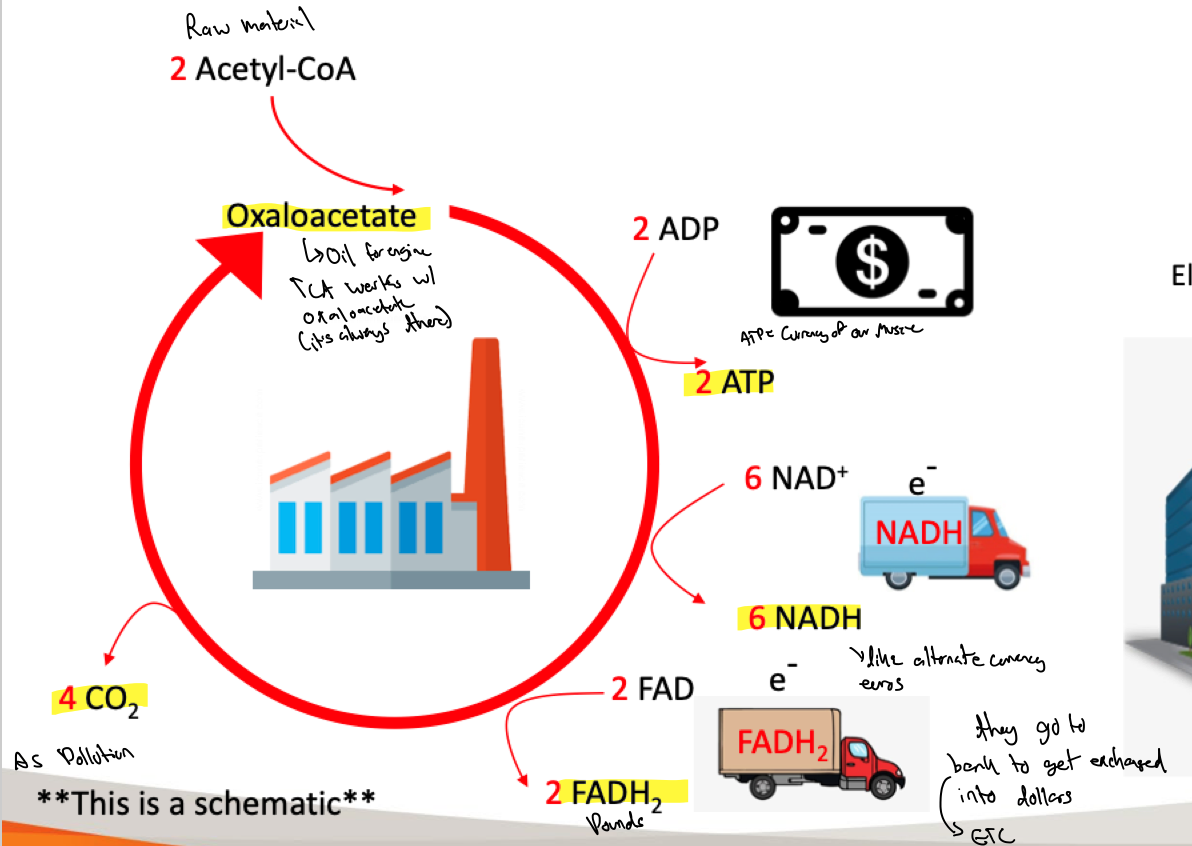
55
New cards
Draw the electron transport chain & describe it
Involves 4 protein complexes in the inner mitochondrial membrane:
* Dehydrogenase enzymes remove electrons from hydrogen
* Electrons are passed along cytochomes
* pump hydrogens to the intermembrane space
* creates a proton gradient
* protons pass through ATP synthase
* for every 4H+ transferred through ATP synthase, 1 ADP + Pi produces 1 ATP
* oxygen is the final electron acceptor
* reduced to water
* Dehydrogenase enzymes remove electrons from hydrogen
* Electrons are passed along cytochomes
* pump hydrogens to the intermembrane space
* creates a proton gradient
* protons pass through ATP synthase
* for every 4H+ transferred through ATP synthase, 1 ADP + Pi produces 1 ATP
* oxygen is the final electron acceptor
* reduced to water
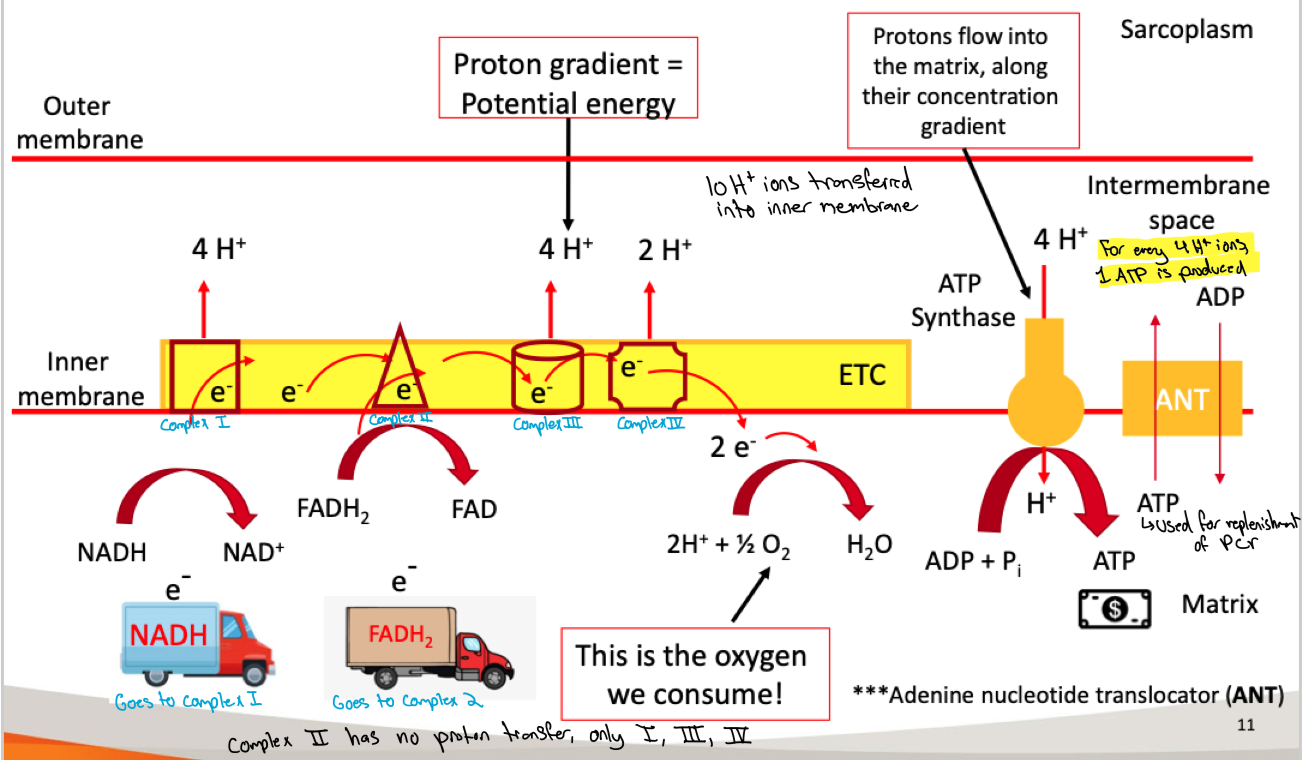
56
New cards
What complexes in the ETC have a proton transfer?
Complexes 1, 3 & 4
* 3 has no proton transfer
* 3 has no proton transfer
57
New cards
What occurs w/ ATP synthase?
\
NADH & FADH2?
\
NADH & FADH2?
* Catalyzes the formation of ATP from ADP & Pi
* Driven by influx of H+ into mitochondria matrix
\
**1 NADH is worth 2.5 ATP**
* b/c it translocates 10 H+ ions
\
**1 FADH2 is worth 1.5 ATO**
* b/c it translocates 6 H+ ions
* Driven by influx of H+ into mitochondria matrix
\
**1 NADH is worth 2.5 ATP**
* b/c it translocates 10 H+ ions
\
**1 FADH2 is worth 1.5 ATO**
* b/c it translocates 6 H+ ions
58
New cards
Glycolysis produces how much from 1 glucose?
\
* ATP
* NADH + H+ (ATP)
* Pyruvate
\
* ATP
* NADH + H+ (ATP)
* Pyruvate
**2** ATP
**2** NADH + H+ (**5** ATP)
**2** Pyruvate
**2** NADH + H+ (**5** ATP)
**2** Pyruvate
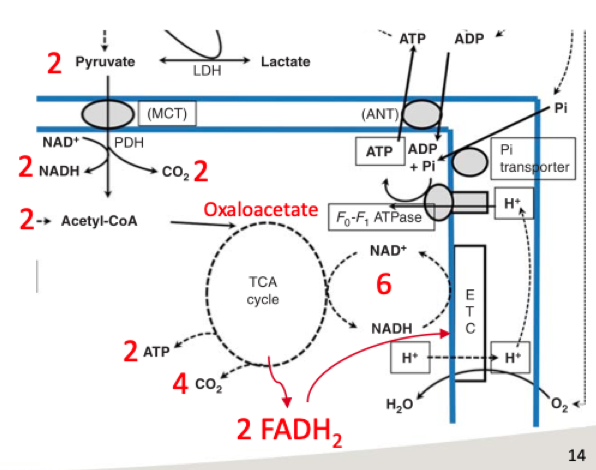
59
New cards
What’s produced from the Citric Acid cycle
\
NADH (ATP)
CO2
FADH2 (ATP)
ATP
\
NADH (ATP)
CO2
FADH2 (ATP)
ATP
**6** NADH (**15** ATP)
**4** CO2
**2** FADH2 (**3** ATP)
**2** ATP
**4** CO2
**2** FADH2 (**3** ATP)
**2** ATP
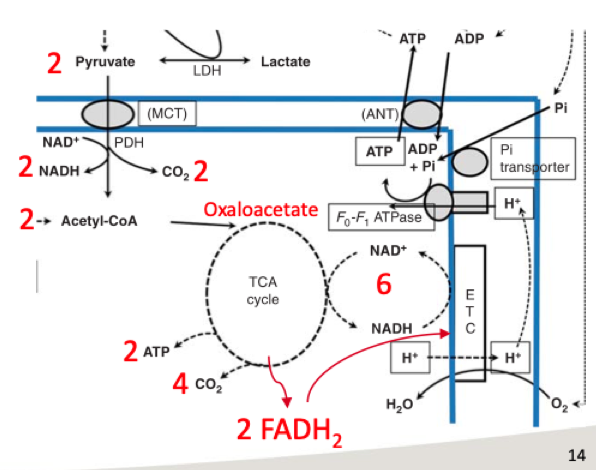
60
New cards
What is produced from pyruvate dehydrogenase?
\
NADH (ATP)
CO2
\
NADH (ATP)
CO2
**2** NADH (**5** ATP)
**2** CO2
**2** CO2
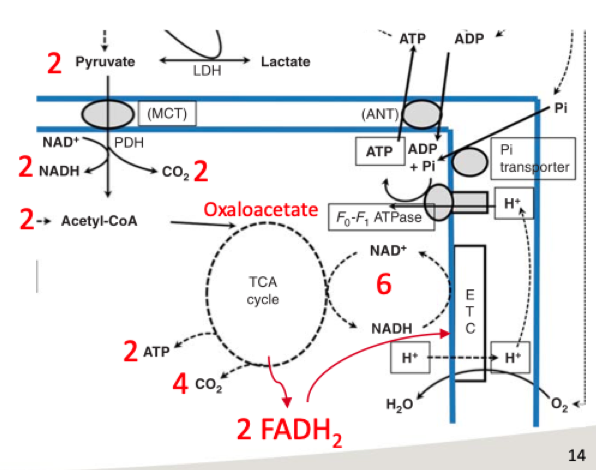
61
New cards
What is the total yield produced from aerobic glycolysis?
\
CO2
ATP
NADH (ATP)
FADH2 (ATP)
\
CO2
ATP
NADH (ATP)
FADH2 (ATP)
**6** CO2
**4** ATP
**10** NADH (**25** ATP)
**2** FADH2 (**3** ATP)
**4** ATP
**10** NADH (**25** ATP)
**2** FADH2 (**3** ATP)
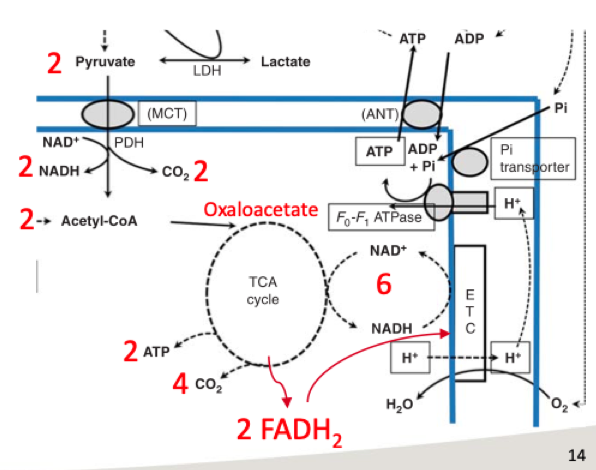
62
New cards
What is slow to activate but has the greatest capacity to produce ATP?
Oxidative phosphorylation
63
New cards
What 3 things are included within the lipid aerobic system?
* Lipolysis & free fatty acid uptake in skeletal muscle
* beta-oxidation
* oxidative phosphorylation
* beta-oxidation
* oxidative phosphorylation
64
New cards
Describe the structure of a triglyceride
\
Where are they stored?
\
How does it relate to ATP
\
Where are they stored?
\
How does it relate to ATP
Only lipid that is a major source of energy (ATP) for muscle
\
* Structure:
* glycerol backbone
* 3 free fatty acid tails
\
Stored in adipose tissue or skeletal muscle
\
* Structure:
* glycerol backbone
* 3 free fatty acid tails
\
Stored in adipose tissue or skeletal muscle
65
New cards
What is the purpose of lipolysis
Involves the breakdown of triglycerides
* Releases the attached FFA tails from the glycerol backbone
\
Via Hydrolysis
\
Enzyme: Adipose triglyceride lipase (ATGL)
* Releases the attached FFA tails from the glycerol backbone
\
Via Hydrolysis
\
Enzyme: Adipose triglyceride lipase (ATGL)
66
New cards
How is a triglyceride broken down via lipolysis?
Triglyceride → Diglyceride → Monoglyceride → glycerol
\
Each break down results in the release of a FFA
\
Each break down results in the release of a FFA

67
New cards
Describe lipid uptake
FFA carried by albumin in blood
* enter via carrier proteins or facilitated diffusion
\
* chaperoned by fatty acid binding protein (FABP) in cell
* enter via carrier proteins or facilitated diffusion
\
* chaperoned by fatty acid binding protein (FABP) in cell

68
New cards
How do FFAs get into the mitochondria?
FFA is converted to **fatty acyl-CoA** & transported unto the mitochondria
* occurs via fatty acyl-CoA synthase
\
FFA is like the line of grocery carts, this is difficult to transfer in the mitochondria & therefore need to be activated to fatty acyl-CoA
* occurs via fatty acyl-CoA synthase
\
FFA is like the line of grocery carts, this is difficult to transfer in the mitochondria & therefore need to be activated to fatty acyl-CoA
69
New cards
What is the Carnitine Shuttle?
Plays an essential role in the transfer of long-chain fatty acids across the inner mitochondrial membrane
\
* Shuttle going in & out taking fatty acyl-CoA inside the mitochondria
\
* Shuttle going in & out taking fatty acyl-CoA inside the mitochondria
70
New cards
What is the purpose of beta oxidation?
To convert fatty acyl-CoA to acetyl CoA so it can enter the TCA cycle
71
New cards
Describe beta-oxidation
\
Input
Output
\
Input
Output
Input:
* Fatty acyl-CoA
* FAD
* NAD+
* CoA (enzyme)
\
Output:
* Acetyl-CoA + fatty acyl-CoA (n-2)
* NADH
* FADH2
\
Fatty acyl-CoA shrinks by 2-carbons every cycle
* 18C FFA goes through 8 cycles
* At the end of the final cycle, **2 carbon-acetyl-CoA** molecules are left
* 18-2 (n-2) = 16 ÷ 2 = 8 cycles
* Fatty acyl-CoA
* FAD
* NAD+
* CoA (enzyme)
\
Output:
* Acetyl-CoA + fatty acyl-CoA (n-2)
* NADH
* FADH2
\
Fatty acyl-CoA shrinks by 2-carbons every cycle
* 18C FFA goes through 8 cycles
* At the end of the final cycle, **2 carbon-acetyl-CoA** molecules are left
* 18-2 (n-2) = 16 ÷ 2 = 8 cycles
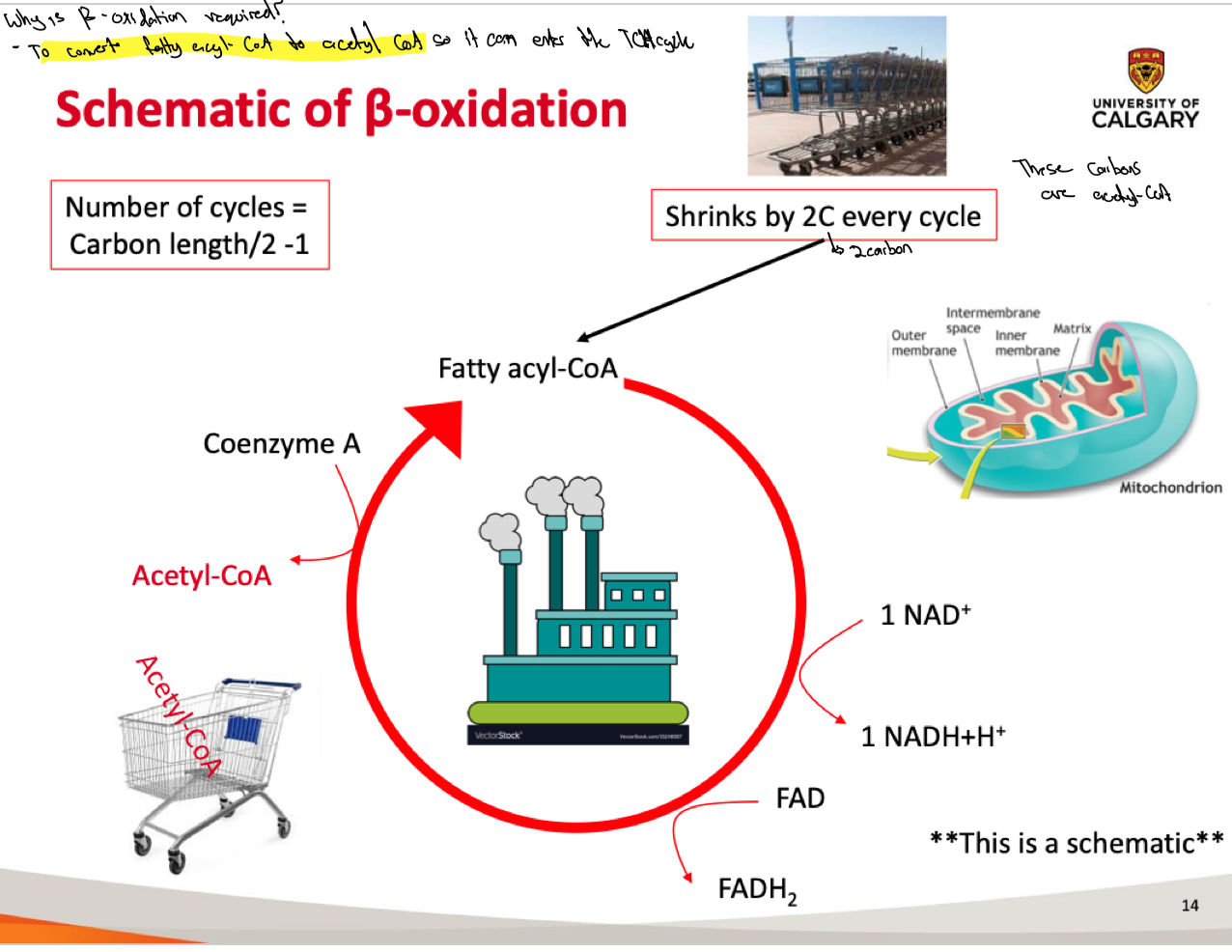
72
New cards
What is the ATP production from beta-oxidation
18C free fatty acid = -2ATP
NADH & FADH2 = 32 ATP
9 Acetyl-CoA → TCA cycle = 90 ATP
\
**1 Free Fatty Acid = 120 ATP**
NADH & FADH2 = 32 ATP
9 Acetyl-CoA → TCA cycle = 90 ATP
\
**1 Free Fatty Acid = 120 ATP**
73
New cards
What is the total yield from aerobic metabolism of triglycerides?
ATP from glycerol backbone
ATP from 3 FFA
\
Glycerol backbone
* Enters glycolysis
* **16 ATP**
\
Beta oxidation
* 3 x 18C FFA
* **360 ATP**
\
Total yield:
* **376 ATP from 1 triglyceride**
ATP from 3 FFA
\
Glycerol backbone
* Enters glycolysis
* **16 ATP**
\
Beta oxidation
* 3 x 18C FFA
* **360 ATP**
\
Total yield:
* **376 ATP from 1 triglyceride**
74
New cards
How does carbohydrate oxidation (glucose) compare to Free fatty acid oxidation (stearic acid) for ATP production?
FFA oxidation is going to produce **more ATP per gram**
BUT
more oxygen is needed to get the same amount of ATP from lipid compared to carbohydrates
THEREFORE
per unit of oxygen, carbohydrates are more efficient
\
BUT
more oxygen is needed to get the same amount of ATP from lipid compared to carbohydrates
THEREFORE
per unit of oxygen, carbohydrates are more efficient
\
75
New cards
What methods are used to assess fuel use?
Pulmonary gas exchange
* O2 uptake & CO2 production
\
Arterial & venous blood sampling
\
Muscle biopsies
\
Stable isotopes
* O2 uptake & CO2 production
\
Arterial & venous blood sampling
\
Muscle biopsies
\
Stable isotopes
76
New cards
What is RER?
Respiratory exchange ratio
\
carbon dioxide production divided by oxygen uptake
\
RER = VCO2 / VO2
\
carbon dioxide production divided by oxygen uptake
\
RER = VCO2 / VO2
77
New cards
How do you know if carbohydrates or lipids are being used as fuel using RER?
If RER = 1.0
* Fuel: carbohydrates
\
If RER = 0.71
* Fuel: lipid
\
If RER is b/w 0.71 & 1.0
* Fuel: mix
* Fuel: carbohydrates
\
If RER = 0.71
* Fuel: lipid
\
If RER is b/w 0.71 & 1.0
* Fuel: mix
78
New cards
Per litre of O2, carbohydrates produce ? kcals than fat
produce **more kcals than fat**
* more efficient
* more efficient
79
New cards
What influences substrate oxidation (whether we use lipid or carbohydrate)?
* Exercise intensity
* exercise duration
* substrate availability
* sex
* training status
* exercise duration
* substrate availability
* sex
* training status
80
New cards
Describe substrate oxidation and exercise intensity in terms of **percentage**
Fat oxidation - major energy source
* at rest to \~60-65% of VO2max
\
Carbohydrate oxidation - major energy source
* >60-65% of VO2 max
\
Lipid is used sparingly when exercise intensity is greater than 65% of VO2 max
* at rest to \~60-65% of VO2max
\
Carbohydrate oxidation - major energy source
* >60-65% of VO2 max
\
Lipid is used sparingly when exercise intensity is greater than 65% of VO2 max
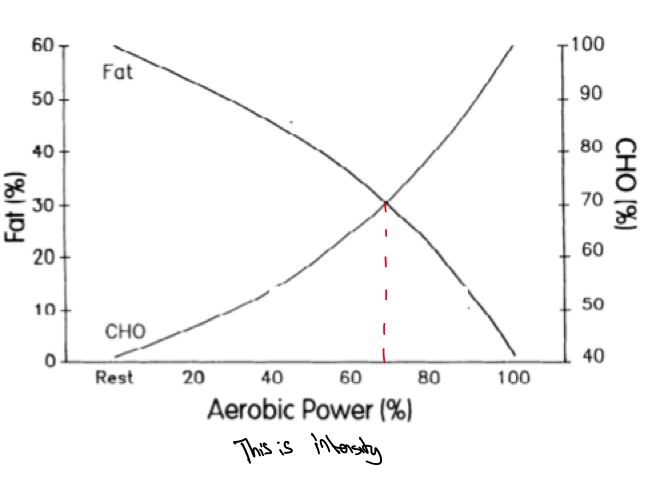
81
New cards
Describe substrate oxidation and exercise intensity in terms of **total energy**
\
25% VO2max
\
65% VO2max
\
85% VO2max
\
25% VO2max
\
65% VO2max
\
85% VO2max
25% VO2max
* Majority contribution = **plasma FFA**
\
65% VO2max
* Muscle glycogen comes into action
\
85% VO2max
* Reduction in fat metabolisms
* Increase in glucose & glycogen
\
Trend:
* As intensity increases, Fat metabolisms decrease & carbohydrate metabolisms increase
* Majority contribution = **plasma FFA**
\
65% VO2max
* Muscle glycogen comes into action
\
85% VO2max
* Reduction in fat metabolisms
* Increase in glucose & glycogen
\
Trend:
* As intensity increases, Fat metabolisms decrease & carbohydrate metabolisms increase
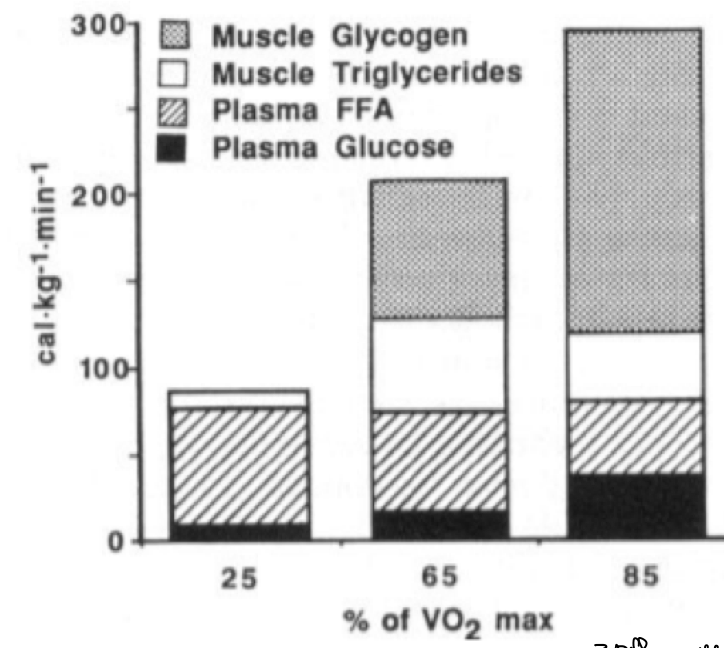
82
New cards
There are exponential increments in ? as functions of relative exercise intensity
muscle glycolysis & glycogenolysis
83
New cards
There is multicomponent response of ? utilization w/ different intensity exercise
plasma FFA & triglycerides
84
New cards
carbohydrate loading before exercises increases ?
carbohydrate loading before exercises increases **carbohydrate oxidation & glycogenolysis**
\
If you consume carbohydrates prior to exercise, body is going to use those carbs for energy first (higher RER)
\
No carbohydrate consumption
* plasma glucose decreases
* burn fat
\
If you consume carbohydrates prior to exercise, body is going to use those carbs for energy first (higher RER)
\
No carbohydrate consumption
* plasma glucose decreases
* burn fat
85
New cards
What is the effect of elevating pre-exercise muscle glycogen contents above normal resting values?
\
High-intensity
Moderate (low) intensity
Fatigue
Performance improvements?
\
High-intensity
Moderate (low) intensity
Fatigue
Performance improvements?
* No effect on high-intensity exercise lasting less than 5 min
\
* no effect on moderate (low) intensity lasting 60-90 min
\
* postpones fatigue by 20% in endurance events lasting more than 90 min
\
* 2-3% performance increase
\
* no effect on moderate (low) intensity lasting 60-90 min
\
* postpones fatigue by 20% in endurance events lasting more than 90 min
\
* 2-3% performance increase
86
New cards
How does sex influence substrate oxidation
Higher fat oxidation during exercise in **females**
* contributes to a higher percentage of energy production compared to males
\
Males use more carbohydrate oxidation
* get fatigued faster
* contributes to a higher percentage of energy production compared to males
\
Males use more carbohydrate oxidation
* get fatigued faster
87
New cards
Impact of training status on substrate oxidation
Trained individuals have a lower RER at higher exercise intensities b/c they use fat oxidation & not carbohydrates so they can maintain glycogen (prevent fatigue)
88
New cards
Compared to untrained individuals w/ a lesser aeroic capacity, endurance-trained athletes w/ a greater aerobic capacity:
* Perform a given task at ?
* derive a **lower** percentage of energy from ?
* drives a **greater** percentage of energy from?
* Perform a given task at ?
* derive a **lower** percentage of energy from ?
* drives a **greater** percentage of energy from?
Perform a given task at **a lower relative exercise intensity**
\
derive a lower percentage of energy from **carbohydrate fuel sources (glycogen, glucose, lactate)**
\
drives a greater percentage of energy from **lipid energy sources** (plasma FFA, intramuscular triglycerdies)
\
derive a lower percentage of energy from **carbohydrate fuel sources (glycogen, glucose, lactate)**
\
drives a greater percentage of energy from **lipid energy sources** (plasma FFA, intramuscular triglycerdies)
89
New cards
What is the advantage of lipid oxidation?
Fat produces almost twice the amount of energy per gram of substrate
\
but
\
carbs are more efficient per unit of oxygen (require less O2)
\
but
\
carbs are more efficient per unit of oxygen (require less O2)
90
New cards
T/F: Preloading muscle glycogen above normal resting values has no effect on endurance performance
FALSE
\
enhances endurance performance
\
enhances endurance performance
91
New cards
Describe an overview of the body’s response to exercise
Exercise results in stress responses
\
Endocrine system produces hormones transferred via blood
\
Target tissue - cellular receptors interaction w/ hormones
\
Results in __homeostatic & allostatic responses__ to manage stress responses
\
Endocrine system produces hormones transferred via blood
\
Target tissue - cellular receptors interaction w/ hormones
\
Results in __homeostatic & allostatic responses__ to manage stress responses
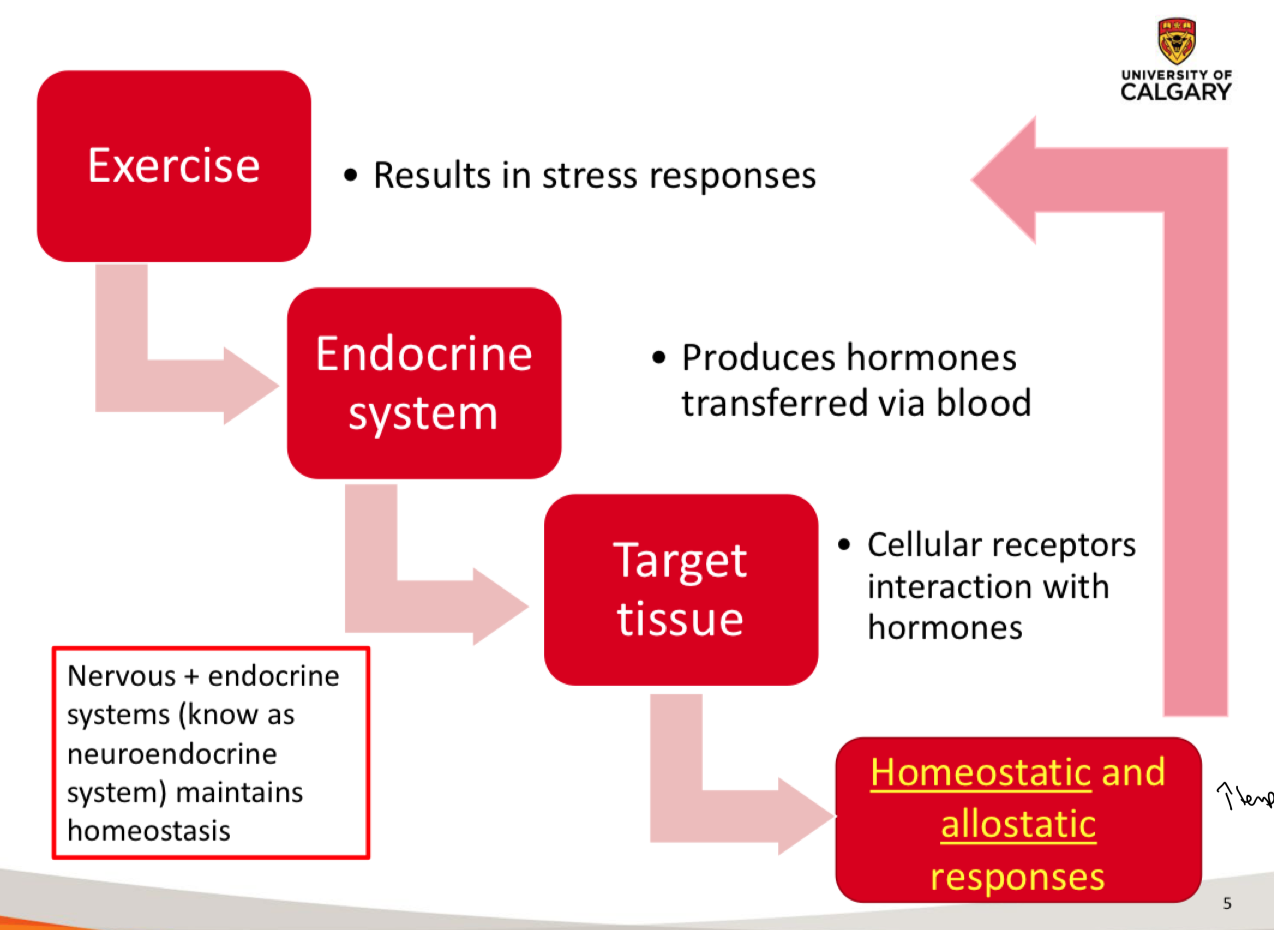
92
New cards
How does glucose & fat regulate exercise?
Exercise
* Decrease intra & extracellular substrate (glycogen, FFA, etc)
* Need to replace these substrates
\
Endocrine systen
* Produces glucagon, EP, NEP, cortisol
* hormones get released
\
Target tissue
* Liver & muscle cells
\
Glucose & fat regulation
* hormones increase glucose, glycogen & FFA levels
* Decrease intra & extracellular substrate (glycogen, FFA, etc)
* Need to replace these substrates
\
Endocrine systen
* Produces glucagon, EP, NEP, cortisol
* hormones get released
\
Target tissue
* Liver & muscle cells
\
Glucose & fat regulation
* hormones increase glucose, glycogen & FFA levels
93
New cards

Fill out the table
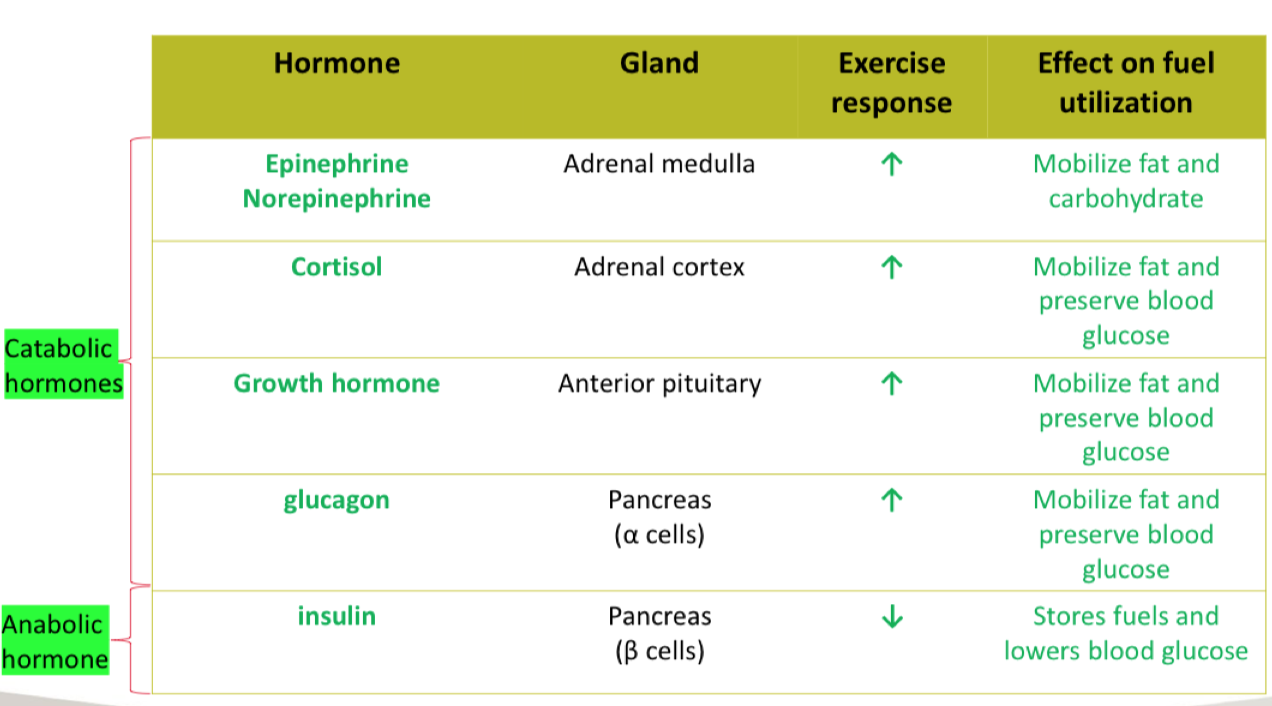
94
New cards
What are the catabolic & anabolic hormones (5)
Catabolic
* epinephrine / norepinephrine
* cortisol
* growth hormone
* glucagon
\
Anabolic
* Insulin
* epinephrine / norepinephrine
* cortisol
* growth hormone
* glucagon
\
Anabolic
* Insulin
95
New cards
During exercise, the rate of carbohydrate & oxidation ?
**increases**
96
New cards
Describe the hormonal control of substrate mobilization during exercise
3 pathways activated by catecholamines (EP & NEP)
\
Liver:
* glycogen → glucose
\
Adipocyte:
* Triglycerides → FFA + glycerol
\
Tissue:
* ↑ FFA oxidation
\
Tissue:
* Glucose entry to the muscle is blocked (during exercise)
\
These maintain blood glucose
\
Once we have these three pathways, we don’t need glucose to the muscle anymore which is why we block it
\
Liver:
* glycogen → glucose
\
Adipocyte:
* Triglycerides → FFA + glycerol
\
Tissue:
* ↑ FFA oxidation
\
Tissue:
* Glucose entry to the muscle is blocked (during exercise)
\
These maintain blood glucose
\
Once we have these three pathways, we don’t need glucose to the muscle anymore which is why we block it
97
New cards
Muscle glycogenolysis is triggered by ?
During exercise, we see a depletion in glycogen
\
Redundant (multiple systems)
* increase in plasma epinephrine
* increase Ca2+ during muscle contraction
\
Redundant (multiple systems)
* increase in plasma epinephrine
* increase Ca2+ during muscle contraction
98
New cards
Insulin & Glucagon
\
Role:
They are called:
\
Role:
They are called:
2 hormones respond to the same stimulus
\
They result in opposite responses regarding the __mobilization of lower glucose & adipose tissue FFA__
\
aka **Counter-regulating hormones**
\
They result in opposite responses regarding the __mobilization of lower glucose & adipose tissue FFA__
\
aka **Counter-regulating hormones**

99
New cards
Describe the 2 mechanisms for skeletal muscle glucose uptake:
**Insulin signalling**
* Secrete insulin which leads to a cascade that mobilizes GLUT4 & activates vesicles
\
**Muscle Contractions**
* Mechanical stretch via Ca2+ & AMP that does the same thing
* Secrete insulin which leads to a cascade that mobilizes GLUT4 & activates vesicles
\
**Muscle Contractions**
* Mechanical stretch via Ca2+ & AMP that does the same thing
100
New cards
What hormones acts to decrease blood glucose & how does it do it
Insulin
* anabolic hormone
\
↑ muscle protein synthesis & ↓ muscle protein breakdown
\
↑ FFA & triglyceride synthesis in adipose tissue & liver
\
↑ glycogen synthesis & ↓ glycogenolysis in liver & muscle
* anabolic hormone
\
↑ muscle protein synthesis & ↓ muscle protein breakdown
\
↑ FFA & triglyceride synthesis in adipose tissue & liver
\
↑ glycogen synthesis & ↓ glycogenolysis in liver & muscle